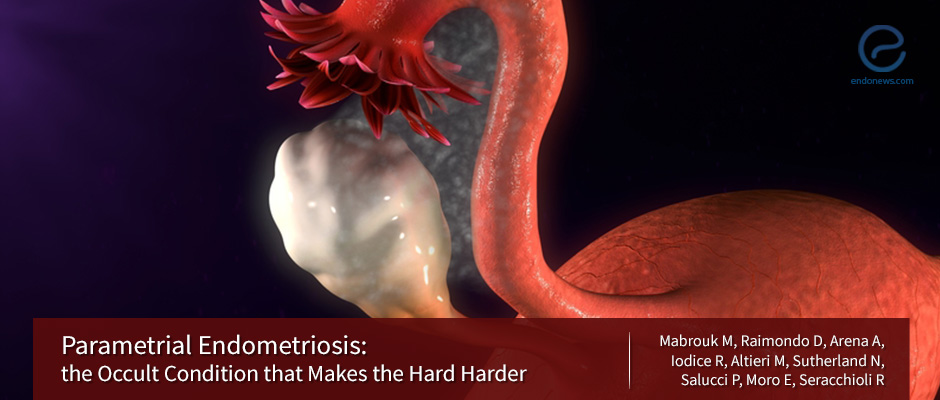Parametrial endometriosis: A harder form of endometriosis
Oct 18, 2018
All patients with deep infiltrating endometriosis should be carefully evaluated for lateral parametrial involvement.
Key Points
Highlights:
- Lateral parametrial endometriosis (LPE) is not uncommon as previously thought.
- Thus this condition should be kept in mind during the examination of all patients with deep infiltrating endometriosis.
Importance:
- Lateral parametrial endometriosis is a widespread disease associated with more aggressive and complicated surgical intervention.
- The preoperative suspicion, preoperative workup, and counseling of the patients are essential.
What’s done here?
- The consecutive deep endometriosis patients treated with laparoscopic surgery in a tertiary center at Bologna, Italy, between 2007-2017 were included in this retrospective study.
- The data were collected from the database records, all women underwent detailed physical and gynecological examination. Transvaginal ultrasonography and renal ultrasonography were performed to locate the endometriotic lesions. If necessary, additional urinary tract computed tomography and MRI methods were done.
- All surgical procedures were performed by two gynecologists experienced in the laparoscopic management of endometriosis, by the lysis of adhesions, the stripping of all endometriomas and ovarian suspension, and the isolation and removal of deep implants through a nerve-sparing approach; and endometriosis diagnosis was confirmed by histopathological examination.
- Patients were divided into two groups; with LPE (the study group) and without LPE (the control group); then were compared for the demographic, clinical and the surgical variables by statistics.
Key results:
- Among 1360 women referred for deep endometriosis surgery, 231 (17%) had LPE at surgery (study group), 1129 (83%) without parametrial involvement composed the control group.
- Preoperative diagnosis of parametrial infiltration was successfully performed in 159 women.
- There are statistically significant differences between these two groups:
- The patients with LPE were significantly older, had more severe dysmenorrhea, more frequent voiding and bowel symptoms with more frequent preoperative medical treatments and left side involvement compared to the patients in the control group.
- The incidence of partial colpectomy or ureterectomy was higher in the study group. The operation and the hospitalization periods were longer in the study group.
- The self-catheterization at discharge and at the one-month control were more frequent in the study group.
- The conversion from laparoscopy to laparotomy was required in only 4 women. The laparoscopic removal of all endometriotic implants was achieved in the remaining patients.
Strengths and Limitations:
- The large sample size and surgical performance by experienced gynecologists represent the strength of this study.
- The retrospective design, variation of preoperative workup between the years and the theoretical overestimation of the prevalence of LPE in a tertiary referral center are the limitations.
Lay Summary
Deep infiltrating endometriosis is the most severe manifestation of endometriosis, affecting 20% of all patients with endometriosis. It is defined as the infiltration of ectopic endometrial tissue under the peritoneum, pelvic structures, and the organ walls such as the uterosacral ligaments, colon, vagina, bladder, ureter, rectovaginal septum, and the lateral parametrium.
Lateral parametrium covers the retroperitoneal connective tissue from the uterus to the lateral pelvic wall. If endometriosis spread to the parametrium, the surgical intervention plays a major role in the management. Women with LPE present with more severe pain and more frequent voiding and bowel dysfunctional symptoms.
Mabrouk et al, a group of laparoscopic surgeons from Bologna, Italy, published a retrospective study titled as “Parametrial Endometriosis: the Occult Condition that Makes the Hard Harder” in the journal named as The Journal of Minimally Invasive Gynecology. The authors aimed to evaluate the patients with lateral parametrial involvement among all deep infiltrating endometriosis patients.
All patients were operated by two gynecologists experienced in the laparoscopic management of endometriosis. Patients with and without LPE were compared regarding the demographic, clinical characteristics, and the surgical findings.
It is found that patients in the study group were older and more prone to intraoperative and postoperative complications. These women were also referred with more severe dysmenorrhea, more frequent voiding and bowel symptoms on admission. The authors emphasized that LPE is not as rare as it is thought, and this condition requires a more careful and detailed evaluation at the admission of the patients.
“Patients must be evaluated thoroughly and counseled properly during the preoperative examination, taking into account the significant morbidity, particularly regarding pelvic organ dysfunctions” the authors added.
Research Source: https://www.ncbi.nlm.nih.gov/pubmed/30176361
endometriosis deep infiltrating endometriosis parametrial involvement lateral parametrial endometriosis laparoscopic surgery

